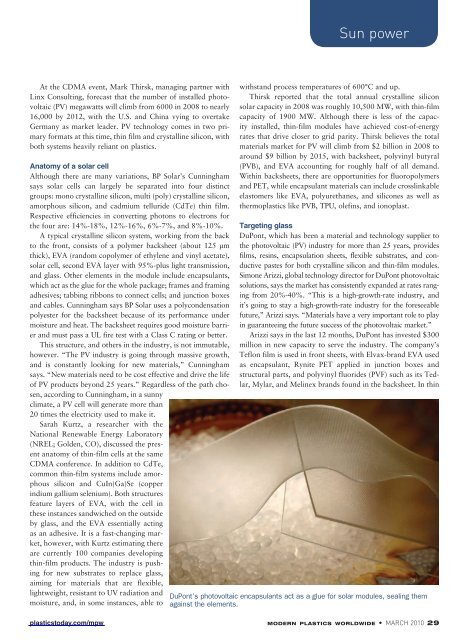Modern Plastics Worldwide - March 2010 - dae uptlax
Modern Plastics Worldwide - March 2010 - dae uptlax
Modern Plastics Worldwide - March 2010 - dae uptlax
Create successful ePaper yourself
Turn your PDF publications into a flip-book with our unique Google optimized e-Paper software.
At the CDMA event, Mark Thirsk, managing partner with<br />
Linx Consulting, forecast that the number of installed photovoltaic<br />
(PV) megawatts will climb from 6000 in 2008 to nearly<br />
16,000 by 2012, with the U.S. and China vying to overtake<br />
Germany as market leader. PV technology comes in two primary<br />
formats at this time, thin film and crystalline silicon, with<br />
both systems heavily reliant on plastics.<br />
Anatomy of a solar cell<br />
Although there are many variations, BP Solar’s Cunningham<br />
says solar cells can largely be separated into four distinct<br />
groups: mono crystalline silicon, multi (poly) crystalline silicon,<br />
amorphous silicon, and cadmium telluride (CdTe) thin film.<br />
Respective efficiencies in converting photons to electrons for<br />
the four are: 14%-18%, 12%-16%, 6%-7%, and 8%-10%.<br />
A typical crystalline silicon system, working from the back<br />
to the front, consists of a polymer backsheet (about 125 μm<br />
thick), EVA (random copolymer of ethylene and vinyl acetate),<br />
solar cell, second EVA layer with 95%-plus light transmission,<br />
and glass. Other elements in the module include encapsulants,<br />
which act as the glue for the whole package; frames and framing<br />
adhesives; tabbing ribbons to connect cells; and junction boxes<br />
and cables. Cunningham says BP Solar uses a polycondensation<br />
polyester for the backsheet because of its performance under<br />
moisture and heat. The backsheet requires good moisture barrier<br />
and must pass a UL fire test with a Class C rating or better.<br />
This structure, and others in the industry, is not immutable,<br />
however. “The PV industry is going through massive growth,<br />
and is constantly looking for new materials,” Cunningham<br />
says. “New materials need to be cost effective and drive the life<br />
of PV products beyond 25 years.” Regardless of the path chosen,<br />
according to Cunningham, in a sunny<br />
climate, a PV cell will generate more than<br />
20 times the electricity used to make it.<br />
Sarah Kurtz, a researcher with the<br />
National Renewable Energy Laboratory<br />
(NREL; Golden, CO), discussed the present<br />
anatomy of thin-film cells at the same<br />
CDMA conference. In addition to CdTe,<br />
common thin-film systems include amorphous<br />
silicon and CuIn(Ga)Se (copper<br />
indium gallium selenium). Both structures<br />
feature layers of EVA, with the cell in<br />
these instances sandwiched on the outside<br />
by glass, and the EVA essentially acting<br />
as an adhesive. It is a fast-changing market,<br />
however, with Kurtz estimating there<br />
are currently 100 companies developing<br />
thin-film products. The industry is pushing<br />
for new substrates to replace glass,<br />
aiming for materials that are flexible,<br />
lightweight, resistant to UV radiation and<br />
moisture, and, in some instances, able to<br />
plasticstoday.com/mpw<br />
Sun power<br />
withstand process temperatures of 600°C and up.<br />
Thirsk reported that the total annual crystalline silicon<br />
solar capacity in 2008 was roughly 10,500 MW, with thin-film<br />
capacity of 1900 MW. Although there is less of the capacity<br />
installed, thin-film modules have achieved cost-of-energy<br />
rates that drive closer to grid parity. Thirsk believes the total<br />
materials market for PV will climb from $2 billion in 2008 to<br />
around $9 billion by 2015, with backsheet, polyvinyl butyral<br />
(PVB), and EVA accounting for roughly half of all demand.<br />
Within backsheets, there are opportunities for fluoropolymers<br />
and PET, while encapsulant materials can include crosslinkable<br />
elastomers like EVA, polyurethanes, and silicones as well as<br />
thermoplastics like PVB, TPU, olefins, and ionoplast.<br />
Targeting glass<br />
DuPont, which has been a material and technology supplier to<br />
the photovoltaic (PV) industry for more than 25 years, provides<br />
films, resins, encapsulation sheets, flexible substrates, and conductive<br />
pastes for both crystalline silicon and thin-film modules.<br />
Simone Arizzi, global technology director for DuPont photovoltaic<br />
solutions, says the market has consistently expanded at rates ranging<br />
from 20%-40%. “This is a high-growth-rate industry, and<br />
it’s going to stay a high-growth-rate industry for the foreseeable<br />
future,” Arizzi says. “Materials have a very important role to play<br />
in guaranteeing the future success of the photovoltaic market.”<br />
Arizzi says in the last 12 months, DuPont has invested $300<br />
million in new capacity to serve the industry. The company’s<br />
Teflon film is used in front sheets, with Elvax-brand EVA used<br />
as encapsulant, Rynite PET applied in junction boxes and<br />
structural parts, and polyvinyl fluorides (PVF) such as its Tedlar,<br />
Mylar, and Melinex brands found in the backsheet. In thin<br />
DuPont’s photovoltaic encapsulants act as a glue for solar modules, sealing them<br />
against the elements.<br />
MODERN PLASTICS WORLDWIDE • MARCH <strong>2010</strong> 29









